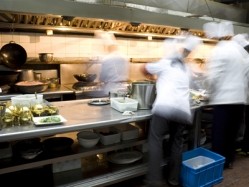ASK THE EXPERTS
How to get rid of unpleasant odours from a commercial kitchen

Problem: Now that winter is here and we aren’t able to open doors and windows as much I’ve noticed that when the kitchen’s not in service there are some lingering odours that are quite unpleasant and are starting to affect front-of-house. We are looking to open in the morning and afternoon to serve coffees and teas, but I fear the smell of food waste will put customers off. I am against using artificial air fresheners as I feel they affect the smell and taste of food when we serve it, so what can we do to eliminate these smells?
Solution: It is common practice to use artificial air fresheners when it comes to bad smells, but all they really do is mask the smell rather than remove it completely. This can often lead to a sickly combination where the bad smell is mixed with the perfume which could certainly be off putting for customers. While air fresheners may not directly affect the food, it needs to be remembered that what smells nice to one person, doesn’t necessarily smell good to someone else. Using this method to cover up smells could certainly affect the customer experience in your restaurant.
Another issue with this form of odour control is that it can be expensive. The chemical air fresheners are consumable items, so if there is a bad odour problem, stocks will have to be replenished month after month. The cost is on-going and soon mounts up making this not only a poor way of dealing with odours, but also an expensive one.
It is more than likely that bad smells from the food waste will be emanating from the refuse storage areas. These will be caused by odours making their way through the storage system or directly from it if it is nearby the kitchen and front of house. These days waste has to be stored inside and the bad odours will build up over time, especially when organic waste is involved which breaks down into an extra smelly liquid. If left un-controlled your customers really will be kicking up a stink.
Carbon filters
If you want to see real results when combatting an odour problem it is time to ditch the air fresheners. One method which can be adopted is the installation of carbon filters. Designed to act as a sponge filtering out the bad smells they are usually installed into the duct work and use fans to pull the affected air through the filter.
While they work much better than chemically 'masking' the smell, the main downsides here are that there can be a big initial outlay to have them installed and they need electricity to drive air through the system. The carbon sponge also has to be replaced on a regular basis as it gets saturated, so there are maintenance costs involved.
Ionisation
To combat these smells once and for all I would recommend the restaurant adopts the ionisation method of odour control. An ionisation unit can be installed onto the wall of a problem area. It is also powered by electricity but it uses a small amount (usually less than 30 watts).
Ionisation systems discharge ions into the room which directly combat the smells through oxidisation, completely eradicating problem odours. The beauty of the ionisation method is that it involves a low initial outlay and doesn't require consumables.
With no chemicals involved and only a small amount of electricity used to power the system you are also doing your bit for the environment.
I believe with this method in place, the only smells the customers will be enjoying is from the tea, coffee and cakes.

































